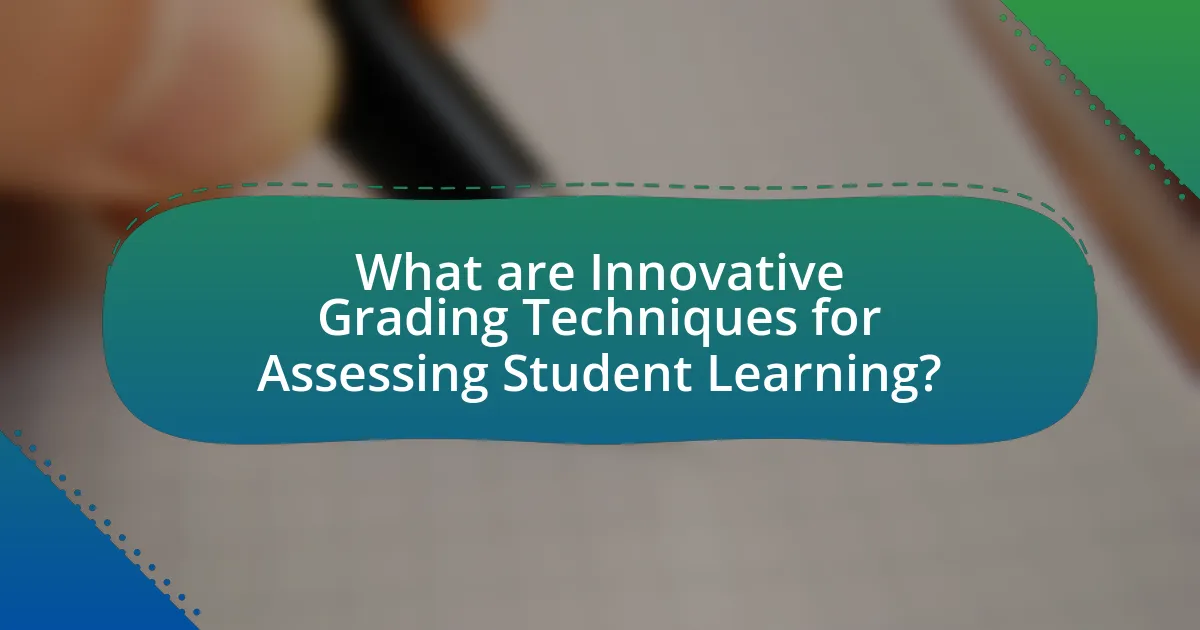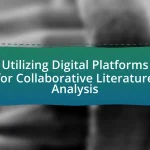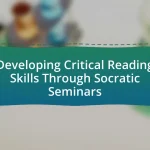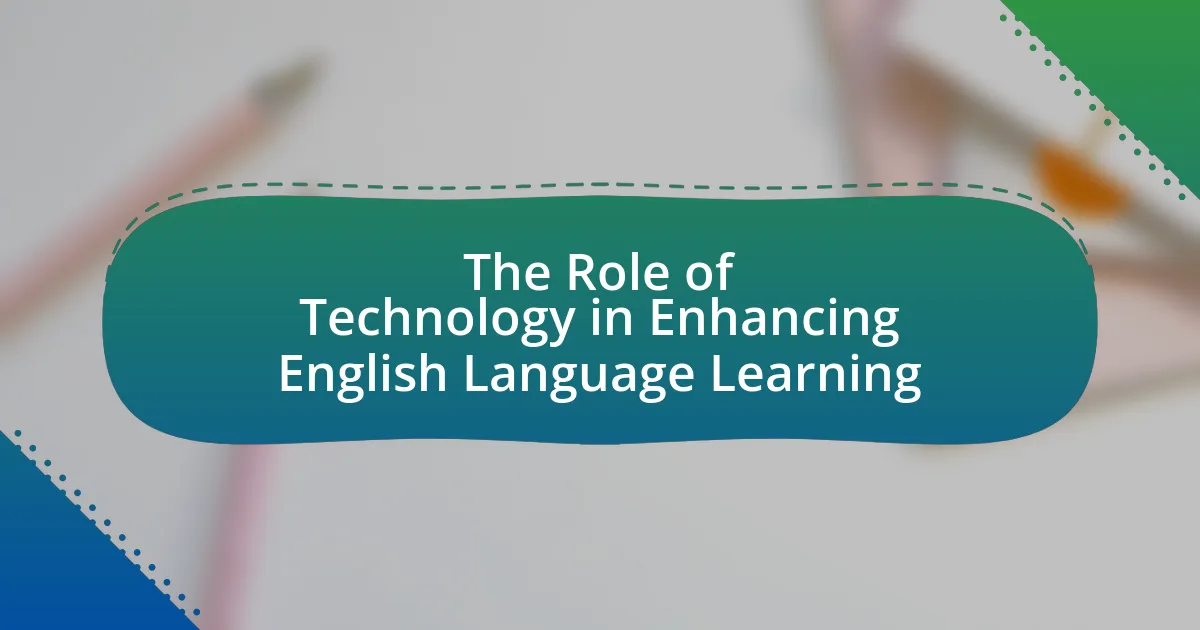The article focuses on innovative grading techniques for assessing student learning, specifically tailored for English instructors. It explores methods such as formative assessments, peer evaluations, and competency-based grading, highlighting their advantages over traditional grading methods that often rely on summative scores. The discussion includes the limitations of conventional assessments, the importance of effective evaluation in enhancing student outcomes, and practical strategies for implementing these innovative techniques. Additionally, it addresses the role of technology and personalized feedback in fostering student engagement and motivation, ultimately aiming to create a more holistic and supportive learning environment.

What are Innovative Grading Techniques for Assessing Student Learning?
Innovative grading techniques for assessing student learning include formative assessments, peer assessments, and competency-based grading. Formative assessments, such as quizzes and reflective journals, provide ongoing feedback that helps students understand their learning progress. Peer assessments encourage collaboration and critical thinking, allowing students to evaluate each other’s work, which enhances their understanding of the subject matter. Competency-based grading focuses on students demonstrating mastery of specific skills or knowledge rather than accumulating points, promoting a deeper understanding of the content. These techniques have been shown to improve student engagement and learning outcomes, as evidenced by studies indicating that formative assessments can lead to a 20% increase in student performance (Black & Wiliam, 1998).
How do these techniques differ from traditional grading methods?
Innovative grading techniques differ from traditional grading methods primarily in their focus on formative assessment and personalized feedback rather than solely on summative scores. Traditional grading often emphasizes a single numerical or letter grade that reflects a student’s performance on tests and assignments, which can overlook individual learning processes and growth. In contrast, innovative techniques prioritize ongoing assessment, allowing instructors to provide continuous feedback that supports student development and encourages a growth mindset. For example, methods such as portfolio assessments or competency-based evaluations enable students to demonstrate their understanding over time, fostering deeper learning and engagement. This shift is supported by research indicating that formative assessments can lead to improved student outcomes by promoting self-reflection and active learning strategies.
What are the limitations of traditional grading methods?
Traditional grading methods have several limitations, including their inability to accurately reflect a student’s understanding and skills. These methods often rely on standardized tests and numerical scores, which can overlook individual learning styles and the complexities of student performance. Research indicates that traditional grading can create anxiety and discourage risk-taking in learning, as students may focus more on grades than on mastering content. Additionally, traditional grading does not account for formative assessments, which provide valuable feedback during the learning process, leading to a narrow view of student achievement.
How can innovative techniques address these limitations?
Innovative techniques can address limitations in assessing student learning by incorporating formative assessments, technology integration, and personalized feedback. Formative assessments, such as peer reviews and self-assessments, allow instructors to gauge student understanding continuously, rather than relying solely on high-stakes testing. Research shows that formative assessments can improve student performance by 20% (Black & Wiliam, 1998).
Technology integration, including online platforms for quizzes and interactive assignments, enhances engagement and provides immediate feedback, which is crucial for learning. A study by the Bill & Melinda Gates Foundation found that technology-enabled assessments can lead to a 30% increase in student engagement.
Personalized feedback, facilitated by innovative grading techniques like rubrics and digital portfolios, helps students understand their strengths and areas for improvement, fostering a growth mindset. According to Hattie and Timperley’s meta-analysis (2007), effective feedback can increase student achievement by up to 30%. These innovative techniques collectively address the limitations of traditional grading methods by promoting a more holistic and supportive learning environment.
Why is it important to assess student learning effectively?
Effective assessment of student learning is crucial because it directly informs educators about students’ understanding and mastery of the material. This understanding allows instructors to tailor their teaching strategies to meet diverse learning needs, thereby enhancing educational outcomes. Research indicates that formative assessments, which provide ongoing feedback, can significantly improve student performance by identifying areas for improvement and guiding instructional adjustments. For instance, a study published in the “Journal of Educational Psychology” by Black and Wiliam (1998) found that effective assessment practices can lead to a 20% increase in student achievement. Thus, effective assessment not only measures learning but also drives instructional effectiveness and student success.
What impact does effective assessment have on student outcomes?
Effective assessment significantly enhances student outcomes by providing targeted feedback that informs instructional practices. Research indicates that when assessments are aligned with learning objectives, students demonstrate improved understanding and retention of material. For instance, a study by Hattie and Timperley (2007) found that feedback from assessments can lead to a 30% increase in student achievement. This correlation underscores the importance of effective assessment in fostering academic growth and guiding educators in refining their teaching strategies.
How does assessment influence teaching strategies?
Assessment directly influences teaching strategies by providing educators with critical data on student understanding and performance. This data allows teachers to tailor their instructional methods, ensuring they address specific learning needs and gaps. For instance, formative assessments, such as quizzes and class discussions, enable instructors to adjust their teaching in real-time, enhancing student engagement and comprehension. Research indicates that differentiated instruction, informed by assessment results, leads to improved student outcomes, as it allows for personalized learning experiences that cater to diverse abilities and learning styles.
What role do English instructors play in student assessment?
English instructors play a crucial role in student assessment by evaluating students’ language skills, comprehension, and critical thinking abilities. They design assessments that align with learning objectives, ensuring that evaluations accurately reflect students’ understanding of the material. Furthermore, English instructors provide constructive feedback, which helps students identify areas for improvement and fosters their growth in language proficiency. Research indicates that effective assessment practices, such as formative assessments and peer reviews, enhance student engagement and learning outcomes, demonstrating the significant impact of English instructors on student success.
How can English instructors implement innovative grading techniques?
English instructors can implement innovative grading techniques by utilizing formative assessments, peer evaluations, and digital portfolios. Formative assessments, such as quizzes and reflective journals, allow instructors to gauge student understanding continuously rather than relying solely on high-stakes exams. Peer evaluations encourage collaboration and critical thinking, as students assess each other’s work, fostering a deeper understanding of the material. Digital portfolios enable students to showcase their progress and achievements over time, providing a comprehensive view of their learning journey. Research indicates that these methods can enhance student engagement and motivation, leading to improved learning outcomes.
What challenges do English instructors face in assessing student learning?
English instructors face several challenges in assessing student learning, including subjectivity in grading, diverse student needs, and the effectiveness of assessment methods. Subjectivity can lead to inconsistencies in grading, as personal biases may influence evaluations. Additionally, the diverse backgrounds and learning styles of students require instructors to adapt assessments, making it difficult to create a one-size-fits-all approach. Furthermore, traditional assessment methods may not accurately reflect a student’s understanding or skills, prompting the need for innovative techniques that can better capture student learning outcomes.
How can innovative grading techniques enhance student engagement?
Innovative grading techniques can enhance student engagement by providing personalized feedback and fostering a growth mindset. These techniques, such as formative assessments and competency-based grading, allow students to understand their strengths and areas for improvement, which motivates them to take an active role in their learning process. Research indicates that when students receive timely and constructive feedback, they are more likely to engage with the material and participate in class discussions. For example, a study published in the “Journal of Educational Psychology” found that students who received regular feedback on their performance showed a 20% increase in engagement levels compared to those who did not. This demonstrates that innovative grading methods not only clarify expectations but also encourage students to invest in their educational journey.
What specific techniques can be used to increase student motivation?
To increase student motivation, specific techniques include setting clear goals, providing timely feedback, and incorporating student interests into the curriculum. Setting clear goals helps students understand expectations and fosters a sense of purpose, which has been shown to enhance motivation (Locke & Latham, 2002). Timely feedback allows students to recognize their progress and areas for improvement, reinforcing their engagement in the learning process (Hattie & Timperley, 2007). Additionally, integrating student interests into lessons can make learning more relevant and enjoyable, leading to increased intrinsic motivation (Schunk, Pintrich, & Meece, 2008).
How do these techniques foster a growth mindset in students?
Innovative grading techniques foster a growth mindset in students by emphasizing effort, resilience, and the learning process over mere performance. These techniques, such as formative assessments and feedback loops, encourage students to view challenges as opportunities for growth rather than obstacles. Research by Dweck (2006) highlights that when students receive constructive feedback focused on their strategies and efforts, they are more likely to develop a belief in their ability to improve through hard work. This shift in perspective promotes persistence and a willingness to embrace challenges, which are key components of a growth mindset.
What are the best practices for implementing innovative grading techniques?
The best practices for implementing innovative grading techniques include establishing clear learning objectives, utilizing diverse assessment methods, and providing timely feedback. Clear learning objectives ensure that both instructors and students understand the goals of the assessment, which aligns with research indicating that clarity enhances student performance (Hattie & Timperley, 2007). Diverse assessment methods, such as project-based assessments, peer evaluations, and self-assessments, cater to different learning styles and promote deeper engagement, as supported by studies showing that varied assessments can improve student motivation and understanding (Gulikers, Bastiaens, & Kirschner, 2004). Timely feedback is crucial for student growth, as it allows learners to reflect on their performance and make necessary adjustments, with evidence suggesting that prompt feedback significantly boosts learning outcomes (Shute, 2008).
How can instructors effectively communicate grading criteria to students?
Instructors can effectively communicate grading criteria to students by providing clear, detailed rubrics that outline expectations for assignments. These rubrics should specify the criteria for evaluation, including performance levels and associated point values, allowing students to understand how their work will be assessed. Research indicates that transparent grading practices enhance student understanding and performance, as evidenced by a study published in the Journal of Educational Psychology, which found that students who received detailed feedback and grading criteria performed better academically. By utilizing rubrics, instructors not only clarify expectations but also foster a more equitable grading process, ultimately improving student engagement and learning outcomes.
What tools and resources are available to support innovative grading?
Innovative grading can be supported by various tools and resources, including digital platforms like Google Classroom, which facilitates assignment management and feedback, and Turnitin, which helps in assessing originality and providing detailed feedback. Additionally, learning management systems (LMS) such as Canvas and Moodle offer features for tracking student progress and integrating diverse assessment methods. Research indicates that these tools enhance engagement and provide real-time analytics, which are crucial for effective grading practices. For instance, a study by the Educause Review highlights that technology integration in grading can lead to improved student outcomes and more personalized learning experiences.
What common pitfalls should instructors avoid when assessing student learning?
Instructors should avoid the pitfall of relying solely on standardized tests when assessing student learning. This approach can lead to a narrow evaluation of student understanding, as it often fails to capture critical thinking, creativity, and practical application of knowledge. Research indicates that diverse assessment methods, such as project-based assessments and formative evaluations, provide a more comprehensive view of student learning and engagement. For instance, a study published in the “Journal of Educational Psychology” by Black and Wiliam (1998) highlights that varied assessment strategies significantly enhance student performance and motivation. Therefore, incorporating multiple assessment formats is essential for a holistic evaluation of student learning.
How can instructors ensure fairness and transparency in grading?
Instructors can ensure fairness and transparency in grading by implementing clear grading rubrics and providing consistent feedback. Clear rubrics outline specific criteria for evaluation, allowing students to understand how their work will be assessed. Consistent feedback helps students identify areas for improvement and reinforces the grading process. Research indicates that transparent grading practices can enhance student trust and engagement, as evidenced by a study published in the Journal of Educational Psychology, which found that students perform better when they understand the grading criteria and receive timely feedback.
What strategies can help mitigate bias in assessment?
To mitigate bias in assessment, educators can implement standardized rubrics, anonymous grading, and diverse assessment methods. Standardized rubrics provide clear criteria for evaluation, reducing subjective interpretations and ensuring consistency across assessments. Anonymous grading removes identifiable information, allowing instructors to focus solely on the quality of work without being influenced by student identities. Additionally, employing diverse assessment methods, such as projects, presentations, and peer evaluations, accommodates different learning styles and reduces the likelihood of bias associated with traditional testing formats. Research indicates that these strategies can lead to fairer and more equitable assessment outcomes, as evidenced by studies showing improved reliability and validity in grading practices when such methods are applied.
What practical tips can English instructors use to assess student learning innovatively?
English instructors can assess student learning innovatively by incorporating project-based assessments, peer evaluations, and digital portfolios. Project-based assessments allow students to engage in real-world tasks that demonstrate their understanding of the material, fostering critical thinking and creativity. Peer evaluations encourage collaboration and provide students with diverse perspectives on their work, enhancing their analytical skills. Digital portfolios enable students to showcase their progress over time, reflecting their learning journey and allowing for personalized feedback. Research indicates that these methods not only improve student engagement but also lead to deeper learning outcomes, as evidenced by studies showing increased retention rates and higher student satisfaction in courses utilizing such innovative assessment techniques.




